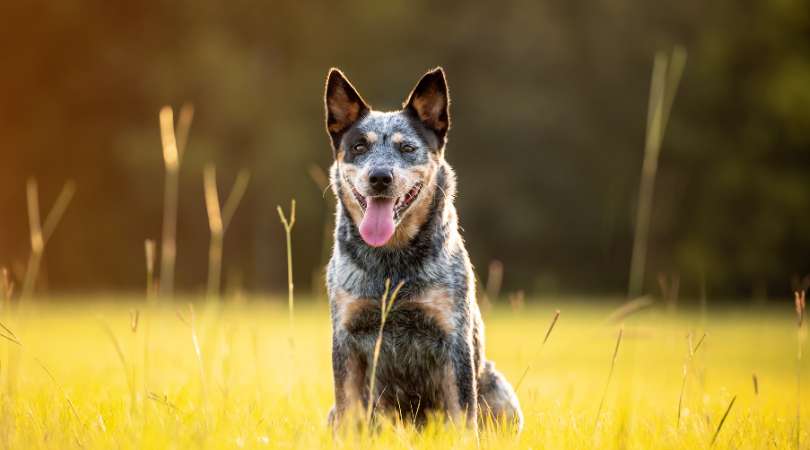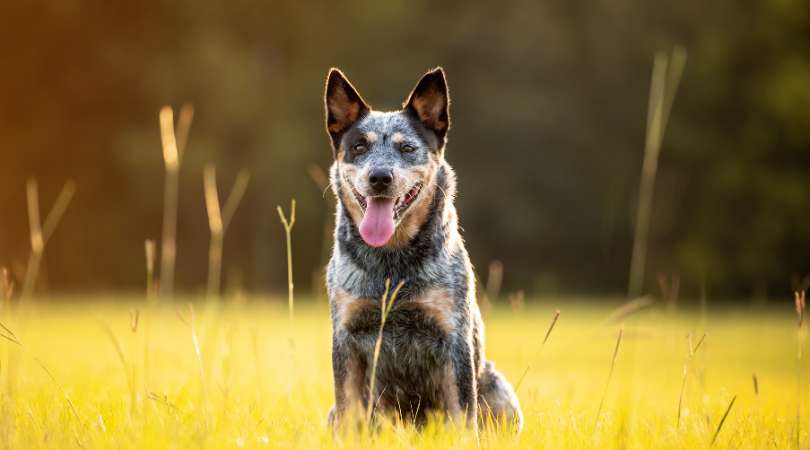Finding The Best Dog Food for Australian Cattle Dogs affectionately known as Blue Heelers or Red Heelers, are intelligent, energetic, and hardworking canines. Renowned for their stamina and versatility, these dogs thrive in active environments and excel as herders, companions, and working dogs. To keep them at their best, providing high-quality nutrition tailored to their unique needs is essential. In this guide, we’ll explore the nutritional requirements of Australian Cattle Dogs and recommend the best dog food options to support their health and vitality.

Understanding the Nutritional Needs of Australian Cattle Dogs
1. Protein
Protein plays a crucial role in the maintenance of muscle mass, the production of energy, and the overall growth and development of your dog. It is important to ensure that your pet receives an adequate amount of protein in their diet to support these vital functions. A diet based on high-quality, animal-based protein should serve as the cornerstone of your dog’s nutritional intake. When selecting dog food, prioritize those products that feature real meat as the primary ingredient, such as chicken, beef, lamb, or fish. This focus on quality ingredients will help ensure that your dog receives the essential nutrients needed for a healthy and active lifestyle.
2. Healthy Fats
Fats serve as a highly concentrated source of energy and play a crucial role in maintaining the health of the skin and coat. Among the different types of fats, omega-3 and omega-6 fatty acids stand out for their exceptional ability to reduce inflammation in the body and to promote the development of a shiny, lustrous coat. These essential fatty acids contribute significantly to overall well-being. Various ingredients such as fish oil, flaxseed, and chicken fat are considered excellent sources of these beneficial fatty acids. Incorporating these specific ingredients into a diet can greatly enhance skin and coat health, ensuring that pets look their best and feel comfortable in their own skin.
3. Carbohydrates
Australian Cattle Dogs, although they do not need carbohydrates to serve as their primary source of energy, can still benefit from the inclusion of complex carbohydrates in their diet. Foods such as sweet potatoes, brown rice, and oats can provide a steady and lasting supply of energy, which can be particularly helpful for their active lifestyle. Additionally, these complex carbs are rich in essential fiber, which plays a crucial role in promoting good digestive health. Incorporating these types of carbohydrates into their meals can enhance their overall well-being and support their energy needs during rigorous activities.
4. Vitamins and Minerals
Vitamins and minerals are essential components that significantly contribute to overall health and well-being, supporting various bodily functions ranging from immune system health to the maintenance of strong bones and teeth. To promote optimal health, it is crucial to ensure that the food we consume contains a variety of essential micronutrients.
Important examples of these micronutrients include calcium, which is vital for healthy bones and teeth; phosphorus, which works alongside calcium to strengthen bone structure; zinc, which plays a key role in immune function and cellular repair; and vitamin E, known for its antioxidant properties that help protect cells from damage. Therefore, paying attention to the nutritional quality of our diet is essential for maintaining good health and preventing deficiencies in these important vitamins and minerals.
5. Calorie Density
Due to their high-energy and active lifestyle, Australian Cattle Dogs require a diet that is not only rich in nutrients but also calorie-dense to ensure they can sustain their energy levels throughout the day. It is essential for these dogs to receive the right amount of calories to support their vigorous activities. The ideal calorie count necessary for each individual dog will vary and is influenced by several important factors, including the dog’s age, weight, and overall activity level. Consequently, it’s crucial to assess these elements carefully to determine the appropriate caloric intake that will best meet your dog’s unique needs.
6. Joint Support
Active breeds of dogs tend to be more susceptible to various joint issues due to their high energy levels and physical activity. To help support their joint health and maintain optimal mobility, it’s important to select dog foods that include beneficial ingredients such as glucosamine and chondroitin. These nutrients are known to promote joint function and can play a significant role in keeping your dog’s joints healthy as they age.

Best Dog Food Options for Australian Cattle Dogs
1. Dry Kibble Options
Why It’s Great:
Orijen employs biologically appropriate recipes high in protein, including free-run chicken, wild-caught fish, and cage-free eggs.
Key Features:
- 85% animal ingredients.
- Grain-free, making it ideal for sensitive stomachs.
- Rich in omega fatty acids for a healthy coat.
2. Taste of the Wild High Prairie Canine Recipe
Why It’s Great:
This recipe features digestible and flavorful novel proteins, such as bison and venison.
Key Features:
- Includes probiotics for digestive health.
- Rich in antioxidants from fruits and vegetables.
- Affordable yet nutritious.
3. Blue Buffalo Wilderness High Protein Grain-Free
Why It’s Great:
This grain-free kibble replicates dogs’ ancestral diet.
Key Features:
- Deboned chicken as the first ingredient.
- Includes Life Source Bits—a blend of antioxidants, vitamins, and minerals.
- No artificial flavors or preservatives.
4. Wet Food Options Hill’s Science Diet Wet Dog Food
Why It’s Great:
Formulated by veterinarians, this wet food provides balanced nutrition in a palatable form.
Key Features:
- Easily digestible ingredients.
- Fortified with vitamins and minerals.
- Ideal for dogs with dental issues.
5. Wellness CORE Grain-Free Hearty Cuts in Gravy
Why It’s Great:
A protein-rich wet food with tender cuts of meat in a flavorful gravy.
Key Features:
- High moisture content supports hydration.
- Contains superfoods like spinach and kale.
- Free of artificial additives.
6. Raw and Freeze-Dried Food Options
Why It’s Great:
Provides the benefits of a raw diet without the hassle of preparation.
Key Features:
- 95% meat, organs, and bone.
- Enhanced with probiotics for gut health.
- Grain-free and minimally processed.
7. Instinct Raw Boost Mixers
Why It’s Great:
These freeze-dried mixers can be added to kibble to enhance flavor and nutrition.
Key Features:
- Made with responsibly sourced protein.
- Contains vegetables and fruits for antioxidants.
- Supports lean muscles and coat health.
Puppy Nutrition for Australian Cattle Dogs
Puppies require different nutrition than adults, so select food specifically formulated to support their growth and development.
Recommended Puppy Food Options:
- Purina Pro Plan Puppy Large Breed: High in DHA for brain development and calcium for strong bones.
- Royal Canin Medium Puppy: Puppy kibble with balanced nutrients and tailored size.
- Wellness Complete Health Puppy: Loaded with high-quality protein and nutritious grains.
Senior Nutrition for Australian Cattle Dogs
As dogs age, their metabolism slows, and they may become less active. Adjust their diet to include:
Recommended Senior Dog Food Options:
- Hill’s Science Diet Senior Dog Food: Formulated for senior dogs, emphasizing joint and heart health.
- Nutro Ultra Senior Dry Dog Food: Combines lean protein with superfoods for enhanced vitality.
- Blue Buffalo Life Protection Formula Senior: Promotes mobility and boosts immune health.
Tips for Feeding Australian Cattle Dogs
1. Follow Portion Guidelines
Start with the feeding recommendations on the food label and adjust according to your dog’s activity level and weight.
2. Monitor Weight
Weigh your dog regularly and check their ribs to ensure they maintain an ideal body condition. Provide Fresh Water: Always keep clean, fresh water available, especially after exercise.
3. Consider Meal Timing:
Split meals into two portions daily to avoid overeating and sustain energy levels.
4. Introduce New Foods Gradually:
Transition to the new food gradually over 7-10 days to prevent gastrointestinal upset.
Conclusion
The ideal dog food for Australian Cattle Dogs varies based on their age, activity level, and health needs. Focus on high-quality ingredients, balanced nutrition, and specific benefits like joint support and digestibility. Whether you choose kibble, wet food, or a raw diet, ensure it suits your dog’s lifestyle and preferences. A proper diet will keep your Australian Cattle Dog healthy, energetic, and loyal for years.
Read More: Best Freeze Dried Dog Food for Sensitive Guts: A Complete Guide 2025



Pingback: Best Dog Food for Blue Heelers: A Complete Guide 2025 - seesarkarijob.com